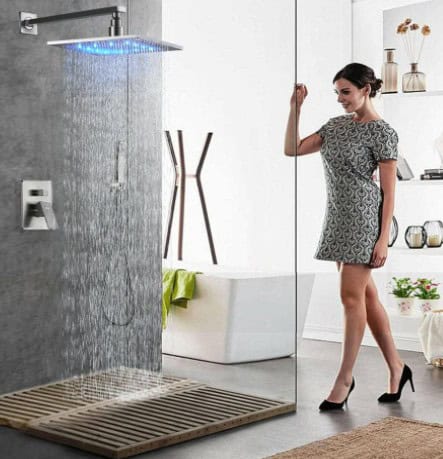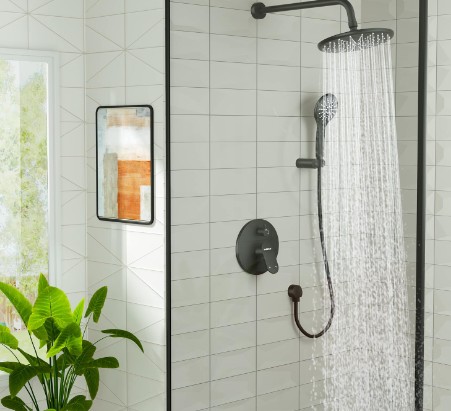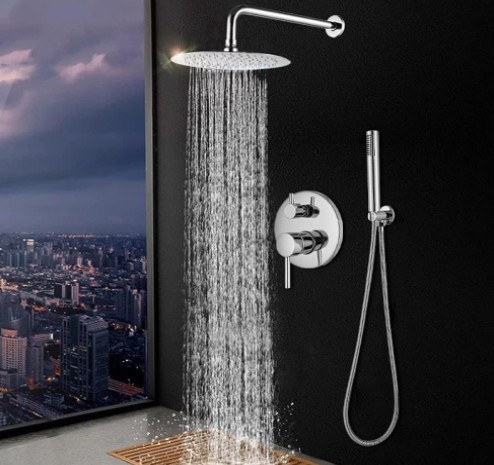As an integral part of a shower, a shower faucet provides you with the comfort of warm water and the relaxation of a good shower. However, problems arise, and shower faucets are not immune to them, hence the importance of a shower faucet troubleshooting guide.
Problems that can arise in a shower faucet are a dripping faucet, temperature fluctuations, low water pressure, leaking handles, and no hot water. Other issues include strange noises, rust or corrosion, showerhead leaks, and no water flow.
The upside is a simple DIY project will help you troubleshoot and fix most of these issues. However, sometimes, the best thing to do is call a professional plumber.
Learn how to prevent and address shower faucet problems.

Shower Faucet Troubleshooting (8 Issues Fixed!)
| Problem | Possible Causes | Recommended Fixes | |
| 1. | Dripping Faucet | Loose handle Worn out or damaged cartridge or O-ring | Tighten the handle Replace the damaged or worn-out O-ring or cartridge |
| 2. | Temperature Fluctuations | Debris and sediment buildup A worn-out cartridge Pressure imbalance | Clean the faucet housing and cartridge Replace the cartridge Adjust the water pressure |
| 3. | Low Water Pressure | Clogged showerhead Pipe obstructions Valve issues Water supply problems | Soak the showerhead in vinegar, then scrub it with a soft brush Unclog the water supply pipes Repair or replace damaged valves Address water supply problems |
| 4. | Leaking Handles | Loose handles Damaged gaskets or O-rings Rust or corrosion | Tighten loose handles Replace worn-out gaskets or O-rings Clean the corroded parts in vinegar or rust remover |
| 5. | No Hot Water | A malfunctioning hot water valve Misadjusted anti-scald feature Sediment buildup | Replace the damaged valve Adjust the anti-scald feature Clean the faucet’s internal components |
| 6. | No Water Flow | Valve or cartridge issues Pipe obstructions Showerhead blockage Handle problems Water supply issues | Replace the valve or cartridge Unblock the pipes Clean the showerhead Replace the handle Open the shut-off valve |
| 7. | Showerhead Leaks | Loose connection Damaged washer Mineral buildup Corrosion | Tighten the showerhead Replace the washer Clean the showerhead Replace the showerhead |
| 8. | Strange Noises | Loose pipes Sediment buildup Water pressure issues Valve problems | Secure the pipes Flush the system Adjust the pressure or use a pressure-reducing valve Repair or replace a damaged valve |
1. Dripping Faucet
While it is a common problem, a dripping faucet is both annoying and wasteful, leading to increased water bills. Over time, the O-ring can deteriorate or loosen, causing water leaks.
Additionally, your shower faucet can start dripping if the cartridge wears out or gets damaged. You might also be dealing with a loose handle.
Fix
- Fix a loose handle by tightening the screw.
- If tightening the handle doesn’t address the problem, remove the handle to access the cartridge and the O-ring.Inspect both for damage or wear. Find replacements for damaged parts.
2. Temperature Fluctuations
Fluctuations can range from sudden cold blasts to scalding hot water unexpectedly, resulting, at the very least, an uncomfortable experience or even burns. Before addressing this problem, let’s examine its potential causes.
a) Pressure Imbalance
Temperature fluctuations often result from cold and hot water supply pressure imbalances. If one supply has significantly more pressure than the other, it can lead to uneven temperature control.
b) Worn Out Cartridge
Over time, the cartridge can wear out or become damaged, causing irregular mixing of hot and cold water sources.
c) Debris and Sediment
The accumulation of debris or sediment within the faucet can disrupt the flow of hot and cold water, leading to inconsistent temperatures.
c) Showerhead Restrictions
A clogged or inefficient showerhead can affect water pressure and temperature by restricting water flow, leading to temperature fluctuations.
Fix
- If your shower faucet has a pressure-balancing valve, adjust it.
- Examine your shower cartridge for blockages, wear, or damage. If you notice any debris or sediment on the cartridge or within the faucet housing, use a soft brush to clean it thoroughly, ensuring you remove any obstructions that might be affecting water flow.
- Replace the cartridge if worn out, damaged, or has a calcium buildup that can’t be easily cleaned.
3. Low Water Pressure
You want sufficient water flowing out of the showerhead for an enjoyable and satisfying shower. Unfortunately, this isn’t possible when the water pressure is low.
If you experience this problem, check whether the showerhead is clogged by mineral deposits or sediment. The water supply pipes might also be obstructed by mineral buildup or debris, restricting water flow.
Moreover, a malfunctioning valve can cause low water pressure.
Fix
- Detach the showerhead and check it for clogs. If mineral deposits are present, soak the showerhead in vinegar to dissolve these deposits, then scrub it with a soft brush to remove any remaining debris. After that, rinse thoroughly and dry it before reattaching.
- If that doesn’t improve water pressure, check the other faucets to determine if the low water pressure is isolated or affects the entire home. If the issue is isolated to the shower, proceed with the next steps.
- Check for obstructions within the water supply pipes.
- Inspect the valves of your shower faucet. Replace or repair it if worn out.
Note
If you have low water pressure in all the faucets throughout your home, the issue might be related to the municipal water supply or the main water line. In this case, contact your water utility provider or a professional plumber to diagnose and address the problem.
4. Leaking Handles
If your shower handles are leaking, check whether they are loose or improperly fitted because such handles don’t create a watertight seal. The gaskets or O-rings might also be damaged.
In addition, inspect your handles for corrosion, especially if you use hard water or live in a humid environment.
Fix
- Tighten the handle with a wrench if it is loose.
- Remove the handle and inspect the internal components for loose or damaged parts. Check the O-rings or gasket for damage and replace them if necessary.
- If you find corrosion, use a rust remover or vinegar to clean the affected areas. Sometimes, you may need to replace the corroded handles or other components. Furthermore, consider installing a water softener to reduce mineral content and minimize rust issues if your water supply is rich in minerals that contribute to corrosion.

5. No Hot Water
This may not be a massive deal if you love cold showers or during warm months. However, you will feel the effect when winter comes or if you generally love warm showers.
The cause of this issue can be traced to different sources, including hot water tank issues and a cross-connection in your plumbing system. The lack of water might also be due to sediment accumulation within the faucet, blocking the flow of hot water and causing a lack of hot water.
A malfunctioning hot water valve can also lead to a lack of hot water. In addition, your shower faucet’s anti-scald feature may be misadjusted, thus restricting hot water flow.
Fix
- If your shower faucet has an anti-scald feature, adjust it. Ensure it is not overly restrictive. You can consult the manufacturer’s instructions.
- Inspect the faucet’s internal components for blockages or sediment buildup. Clean any sediment or debris you find.
- Replace a malfunctioning valve or thermostat.
6. No Water Flow
This problem requires immediate attention since no water means you cannot shower. Common causes of this issue are problems with the faucet’s internal parts, pipe obstructions, handle and cartridge malfunction, and showerhead blockage.
Perhaps the shut-off valve is closed, or the main water supply is faulty.
Fix
- Make sure the shut-off valve is fully open.
- Soak your showerhead in vinegar, then brush, rinse, and dry it if blocked.
- Replace the handle if damaged. This Delta Faucet Foundations 13 Series Single-Function Shower Valve Trim Kit Shower Handle (View on Amazon) has a chrome finish and single lever handle.
- Install a replacement cartridge or valve if the current one is damaged.
7. Leaking Showerhead
Before fixing a leaking showerhead, get to the root cause. Here are the common causes:
i) Loose Connection
Water can seep through the connection between the showerhead and the arm if you do not secure the showerhead properly.
ii) Damaged Washer
The rubber washer can become damaged or deteriorate, leading to leaks.
iii) Mineral Buildup
Water can escape through unintended paths if mineral deposits accumulate in your showerhead’s small openings.
iv) Corrosion
Corrosion can occur in the showerhead, especially if it is metallic. Corrosion can create holes or cracks, allowing water to leak out.
Fix
- Tighten the showerhead if loosely attached to the shower arm.
- Remove the showerhead, then inspect and replace the washer if necessary.
- If you notice mineral buildup on the showerhead, soak the showerhead in a solution of equal parts vinegar and water. Allow it to soak for a few hours, then scrub it with a soft brush to remove any remaining deposits. Rinse the showerhead thoroughly and dry it before reattaching.
- Inspect the showerhead for signs of corrosion. Replace the showerhead with a new one if you find any corroded areas with holes or cracks.

8. Strange Noises
Unusual sounds like whistling, banging, or hissing from your shower faucet could result from different reasons. These are loose pipes vibrating when water passes through them, debris accumulation within the faucet, and water pressure fluctuations.
High pressure can cause a loud whining sound, while low pressure can result in a slow, eerie gurgling. A malfunctioning valve can also create irregular water pressure, leading to unexpected sounds.
Fix
- Secure loose pipes with pipe hangers or insulation.
- Detach the showerhead and run water for a few minutes to clear out debris.
- Adjust the pressure at your water main or use a pressure-reducing valve.
- Replace faulty valves.
Preventive Maintenance
Here are some tips for preventive care to help reduce shower faucet problems.
- Periodically remove and clean your showerhead to prevent mineral buildup.
- Routinely check for leaks around the faucet handles and the showerhead and address them.
- A pressure-reducing valve helps protect plumbing systems from high water pressure, so consider installing it.
- A water softener helps avoid rust and corrosion in mineral-rich water.
- Replace washers or cartridges as soon as you detect a problem to prevent more significant issues.
- Consider an annual check-up by a professional plumber.
- Upgrade to a more efficient modern faucet model if your current one is old or outdated.
Summary of Shower Faucet Troubleshooting
With this guide, you can fix most shower faucet issues and keep your shower faucet in optimal working condition. However, call a plumber to fix major leaks, water pressure problems, and complex repairs.
Here are other interesting topics:
